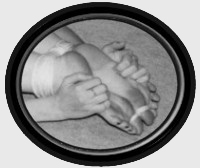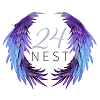Relent<
1st Level Yellow Feather
- Joined
- Sep 8, 2005
- Messages
- 3,233
- Points
- 0
Aygomenians- general term for "humans," of which all ethnicities are regarded.
Phauxnorse- "giants"
Eboniaan- "tree people"
Labrynthian- "elves"
Nymfaqueous- "water nymphs"
Phauxnorse
Physiology-
The Phauxnorse originate from the far north of the mainland, and are similar in every regard to humans with the exception of their size. They tend to be anywhere between 7 and 14 feet tall, weighing from 170 to 350lbs. Despite their large size, they are usually quite gentle unless provoked, and as their musculature suggest they are quite physically adept.
History-
With the relations between their homeland and Aygomenia going so well since the Great War, many Phauxnorse have began emigrating to Aygomnia in search of post-war relief and work. Because they were usually only a little shorter than the trees, their homes are traditionally plots of staked land, with a lean-to for when it rained and a fire pit for their meals. Since moving to Aygomenia, they have began receiving Labor Stipends to live in vast, luxurious houses in which they can fully stand without bumping their heads, though some of the taller of their number tend to scrape their knuckles on the ceiling. Despite being afforded these luxuries through various government programs, they more often than not erect a lean-to and a campfire on their front lawns and use their homes for storage and guest houses. They've proven an invaluable resource for construction and industry.
Appearance-
As stated previously, with the exception of their mammoth size, phauxnorse people are not dissimilar to humans. Their fashion sense may be their one otherwise discerning feature. They are scant dressers, even in public, as they are hard pressed to find fabric or hide large enough to cover the entirety of their bodies. Male phauxnorse are usually shirtless, and females tend to cover only the most essential areas of their torsos. Both are partial to kilts, but with a majority of the population much shorter than they, they've recently adopted undergarments.
Sociology-
In general, giants are very straighforward. They're unable to do things in a manner that's necessarilly sneaky or quiet, so they truthfully have no choice in the matter; but in addition, they also have a certain loathsomeness of underhandedness. They tend to be the center of attention in social settings, and as such have adopted a certain boisterous nature. Homeland phauxnorse tend to display more variety in social settings, as everyone is as large as they are, and its easier to blend in. Mainland phauxnorse can't hide themselves unless behind a veil of sociability. There are a group of disenfranchised laborers who would prefer the phauxnorse return to where they came from, as they're large size and government assistance allow them to not only complete construction jobs much faster than them, but live comfortably at a lower pay scale, thus putting them out of work for brute labor. As far as industry and fabrication go, though, the common man has the advantage of fine machine work, and delicate processes; but they're engaged in fierce competition in this regard as well with the Labyrinthians.
Common slurs against giants include "big'n'talls" and "trolls".
Eboniaan
Physiology-
The Eboniaan people are one of the most complex species of humanoid documented within the entirety of the Aygomenian realm. They’re capable of living for centuries, but at the expense that they must be sedentary for months at a time, sometimes even years or decades depending on the climate. In their sedentary state, they are scarcely discernable from black-bark ebony trees, with the exception that upon close inspection one can usually hear breathing, or sometimes even murmuring.
The bark, also known as “the second skin” is a hardened, calcified, almost invulnerable growth which grows from the eboniaan flesh and eventually constricts their movement . With proper daily practice however they are able to remain fully mobile for decades; by exfoliating their outermost layers each evening, and soaking in a specially prepared bathing solution, they are able to retain a suppleness of flesh which permits them liberty of motion.
The Eboniaan skin is their most majestic feature, but also the one which elicits the greatest degree of scientific curiosity. They are able to regenerate at an alarming rate, even grow new limbs within months if amputated. When the skin becomes dry, it begins to harden, producing the bark described previously. Left unchecked, the bark will engulf the entirety of their flesh, but they may only produce roots and assume their sedentary state in the presence of a certain mineral found in the soil of their homeland. Without, the calcification of their bark becomes deadly, often resulting in their starving to death.
In terms of diet, the eboniaan people may exist solely on water and basic vitamins and minerals. They do not have a typical digestive system, however, though the presence of dietary orifices (located on the head and buttocks) suggest that they once may have, and as they adapted into their sedentary communities came to have no need for them. They absorb water through the pores of their skin, and most chiefly through a root system located in the soles of their feet. In the presence of the unidentified aforementioned mineral from their original habitat, the roots are able to exist outside of their bodies and bind them with some permanence to the earth. Without this mineral, though the surface of their soles are more supple and porous than their bodies, the roots exist internally and through porous absorption absorb their nutrients and water.
The reproduction of eboniaan people may occur sexually or asexually, though the specifics of this have not yet been fully researched in respect to their modesty. Socialogically speaking, they have no dominance of gender as western civilizations have developed, and it is actually quite difficult to tell one gender from another. There are very typically bodied males and females, but also very robust women and rather petite males. They're appearance will vary by region in this regard. It is said that when "aroused", buds form at arbitrary locations on their bodies, and bloom at the apex of orgasm. These blossoms may then be pollenated, and are then internalized during pregnancy. The colors of these blossoms and the colors of the subsequent fruits are usually the color of the parents eyes; taking the trait from either the mother or father. The blossoms may form on either gender, but only the female's blossoms may be pollenated.
History-
Legend has it that an explorer wandering through a dark, uninhabited continent one day decided to strip the bark of a tree so that he could start a fire. After hearing a gasp, he peeled away another layer of bark, thinking perhaps that a fairy was trapped inside. As layer after layer of bark was removed, he began to notice a softening of the surface beneath it, almost like flesh. At length, he’d bared the entire front of a tree to find the heaving breasts and gently rising abdomen of a woman. He somehow convinced her and a small colony of eboniaans to separate their feet from the roots beneath them and help him and his ailing colonials make a permanent settlement in the northern continent. It’s been rumored that his persuasion-- nonviolent as it may have been—was chiefly based upon the principles of ethereal tickling….
Appearance-
The eboniaan people while in their non-sedentary state look completely human, with the exception of pigmentation. Their complexions range from a whitish-gray to ebony black (hence the name of their species) depending on their age and health. Typically, a paleness of hue demarks sickness or age; the darker their complexion, the healthier they are. Their hair is white, and mostly curly, with some variations of thickness and texture. In this regard, they are not dissimilar to cotton plants. Their eyes are usually purple, red, or orange.
Sociology-
Eboniaan communities are usually mistaken for forest, as ideal eboniaan communities are a thicket of bodies at rest, with their roots intertwined beneath the soil. It is said that Eboniaans can communicate with one another through dreams, and had it not been for the settlement of the bizarre continent far away where they were discovered by the Aygomenians, they might have never been awakened or discovered.
It was only during a revolt in the Dark Continent Colonies that the Eboniaan people have acquired their present civil liberties. Because they were easilly disciplined and control of water supplies were simple even in the hands of under-prepared colonial separatists, they existed for decades under the thumbs of Aygomenian Separatists--a radical group of political extremist who were excommunicated from the mainland during the dark ages. More than half a century passed before the Eboniaan people began fleeing the country, and finding allies in the mainland were able to finally unseat their tyrants.
There are still seperatists descendants roaming the mainland as well as the Dark Continent, and some political tension between Aygomenia and the Eboniaan tribes. Common slurs against the Eboniaans include "inkbloods" and "onions".
Labrynthian
Physiology-
Discernible by taller ears than average people, the Labrynthians resided on the mainland of Aygomenia long before their population was thinned by the war and disease of Aygomen settlers. Their only discerning features, other than the length of their ears, are the intricate patterns of pigmentation often found along their backs, legs, arms, or faces. They are also attuned to higher frequencies of hearing and speech, giving them the ability to whisper into the subconscious of other ethnicities, though they usually just use this skill to speak discreetly to one another.
History-
The weaving, wiry patterns that inexplicably mark their skin are said to be the inspiration of modern Victorian fashion, of which they are acreditted. The Labrynthian were the first to apply art to everyday furnishings and objects, and for decades stood apart from the very basic, though functional designs of Aygomenia. As the two nationalities came to reside side by side, their influences began to affect Aygomenian artwork, fashion, architecture, and society. Though Aygomenians are creditted with the mental preparation and proliferation of the Enlightening Era, the Labrynthians were the ones who made thought, art, philosophy, and literature available to the common people. There is still some rivalry between man and Labrynthians, though there is no longer war or violence amongst them politically. Centuries of interbreding with Aygomenians have left the two ethnicities nearly indiscernable from one another, though only the full-blooded Labrynthians have the intricate pigmentations on their skin.
Appearance-
Physically, they may have any pigmentation or other attributes, but tend to mostly be within the range of 5 to 6ft tall, and weigh anywhere from 110-200lbs. Facial piercing is considered amongst them to be a symbol of status, but is not quite as common in the modern era as it was 50 years ago.
Sociology-
There isn't much here to be said that hasn't been mentioned already. Whatever slurs, tensions, and hostilities there were once between common aygomenians and labrynthians are more or less buried. Though some Labrynthians still refer to common people as "deaf twats" in reference to their shorter ears. This term, while unpleasant, tends to be used more as a sociable put down than an actual racism.
Nymfaqueous
Physiology-
Little is known about this race of people as they were only recently discovered with the assistance of new nautical technologies such as the submarine and steam engine. The Nymfaqueous (also regarded as "nymphaqueous" or "nymphs") are a diverse people with the ability to live both in water and on land. They've been mentioned in such pagan lore as mermaids and sirens, though it has been determined that their monstrousness in such depictions was born more from misunderstanding than actual malinity. Nymphaqueous are distinguished commonly by gil slits behind their ears and silver-hued scaling on their elbows, knees, necks, and temples. They are also known to produce "censory scales" which obscure their reproductive or otherwise private areas. The scales may be shed, and used for a variety of medicinal purposes much like eboniaan bark, and flowers, and it is speculated that perhaps the eboniaans and nymphaqueous share some early evolutionary relatives; one which was capable to adapting to genetic variation, in a manner which allowed them to breed with fauna and flora to produce these two subspecies. While a distinctive link between eboniaan and nymphaqueous species have been proposed, no concrete evidence of this has been found; no eboniaan relative which has taken the form of an algae or a kelp species. But I digress. The nymphaqueous have little in common with eboniaans at present, other than perhaps some prehistoric origin. They have been seen with and without limbs such as legs and arms, sometimes posessing a multitude of tentacles, or fins, instead; or rather, any combination of the former and latter. This is supported by several pagan accounts of the nymphaqueous encounters while, say, trapped at sea or on a deserted island.
History-
The nymphaqueous have no documented historical accounts, nor any prior contact with humanity other than random sailors and occassional disenfranchised exiles. They have all manner of collection of the leavings of man, however, such as skeletons, buried treasures, lost nautical equipment, fossils, primitive tools and so on but without any means of discerning the function or form of these objects they're little more than trinkets to them. To informed scientist and researchers however, they're vast collection of trinkets have allowed their existence to be dated back thousands of years. The nymphaqueous have a certain fascination with land-dwelling aygomenians, and it is perhaps their curiosity which has earned them such a poor reputation in terms of pagan lore; dragging sailors from ships and inadvertantly to their deaths because they had no understanding of the concept of drowning. It's likely that the "sirens" of myth were little more than a school of flirtatious girls, or pranksters wanting to destroy mens ships for a laugh. With so much sea exploration taking place now, the nymphaqueous people are becoming far more commonplace, whether they're being brought home by men returning from long voyages, stowing themselve away, or becoming caught in fishermens nets; some particularly audacious ones have even been seen simply walking ashore when they encounter a new settlement and introducing themselves. Because these interactions have become so frequent, and the Era of Enlightenment frowns on rash generalizations and violence, the Aygomenian government has engaged a mission of peace and understanding to prevent any more accidental deaths at sea and improve relations with their otherwise ungoverned (i.e. ungovernable) masses.
Appearance-
The female nymphaqueous are far more common in terms of random encounter, but the males tend to be more secluded and defensive. A female description is simple; they are more or less human looking, with the exception of their scaling, appendages, and gills. They may also have a dual-eyelid: a translucent film which keeps the salt from their eyes as they swim. This film may have a multitude of colors, but when retracted gives the appearance of an eyeshadow on their upperlids. Their noses are somewhat under-defined, almost seemless to their profile and with no excess cartillagenous flesh at the ends of their nasal bridge; while not skeletal in appearance, there nostrils are not easilly discerned from their skin. Their ears are difficult to discern from their gill slits. And they have no hair; eyelashes, perhaps, but none on their brow, scalp, limbs, or pubic area. On land, they've taken a great fondness of wigs to better blend in, but more often than not they don't bother.
The male nymphaqueous is more difficult to describe, as there have been few sightings of them, but based on the few accounts in which they've been encountered they tend to appear more boyish than not, with the same hairlessness and scale configuration as their female counterparts. They lack the rugged contours of a typical male specimen from other ethnicities, in favor of a more streamline anatomy. They are also usually more colorful than their female components, probably for the purposes of mate attratction. Their scale, rather than silver, tend to be shades of blue, green, yellow, pink, and auburn. The retractable film around their eyes is usually more transparent than females' and not easilly discerned from their first eyelid.
Sociology-
The nymphaqueous are a work in progress in terms of proper civilization. They have only a tenative understanding of modern concepts such as property, ownership, and law. As part of the teaching process, they receive no excuses from the government in the case of their arrest, but they tend to be judged less harshly since it is widely known that they don't know any better. They tend to have an affinity for shiny things. In the labor force, they are a favorite of fishermen, when they aren't being caught in their nets, and are invaluable resources for underwater enterprises including but not limited to mining, research, agriculture, and construction. Some hold that they are malicious creatures, who are only garnering the favor of man because they are presently outnumbered; others regard them as little more than children in need of superior guidance and discipline.
Phauxnorse- "giants"
Eboniaan- "tree people"
Labrynthian- "elves"
Nymfaqueous- "water nymphs"
Phauxnorse
Physiology-
The Phauxnorse originate from the far north of the mainland, and are similar in every regard to humans with the exception of their size. They tend to be anywhere between 7 and 14 feet tall, weighing from 170 to 350lbs. Despite their large size, they are usually quite gentle unless provoked, and as their musculature suggest they are quite physically adept.
History-
With the relations between their homeland and Aygomenia going so well since the Great War, many Phauxnorse have began emigrating to Aygomnia in search of post-war relief and work. Because they were usually only a little shorter than the trees, their homes are traditionally plots of staked land, with a lean-to for when it rained and a fire pit for their meals. Since moving to Aygomenia, they have began receiving Labor Stipends to live in vast, luxurious houses in which they can fully stand without bumping their heads, though some of the taller of their number tend to scrape their knuckles on the ceiling. Despite being afforded these luxuries through various government programs, they more often than not erect a lean-to and a campfire on their front lawns and use their homes for storage and guest houses. They've proven an invaluable resource for construction and industry.
Appearance-
As stated previously, with the exception of their mammoth size, phauxnorse people are not dissimilar to humans. Their fashion sense may be their one otherwise discerning feature. They are scant dressers, even in public, as they are hard pressed to find fabric or hide large enough to cover the entirety of their bodies. Male phauxnorse are usually shirtless, and females tend to cover only the most essential areas of their torsos. Both are partial to kilts, but with a majority of the population much shorter than they, they've recently adopted undergarments.
Sociology-
In general, giants are very straighforward. They're unable to do things in a manner that's necessarilly sneaky or quiet, so they truthfully have no choice in the matter; but in addition, they also have a certain loathsomeness of underhandedness. They tend to be the center of attention in social settings, and as such have adopted a certain boisterous nature. Homeland phauxnorse tend to display more variety in social settings, as everyone is as large as they are, and its easier to blend in. Mainland phauxnorse can't hide themselves unless behind a veil of sociability. There are a group of disenfranchised laborers who would prefer the phauxnorse return to where they came from, as they're large size and government assistance allow them to not only complete construction jobs much faster than them, but live comfortably at a lower pay scale, thus putting them out of work for brute labor. As far as industry and fabrication go, though, the common man has the advantage of fine machine work, and delicate processes; but they're engaged in fierce competition in this regard as well with the Labyrinthians.
Common slurs against giants include "big'n'talls" and "trolls".
Eboniaan
Physiology-
The Eboniaan people are one of the most complex species of humanoid documented within the entirety of the Aygomenian realm. They’re capable of living for centuries, but at the expense that they must be sedentary for months at a time, sometimes even years or decades depending on the climate. In their sedentary state, they are scarcely discernable from black-bark ebony trees, with the exception that upon close inspection one can usually hear breathing, or sometimes even murmuring.
The bark, also known as “the second skin” is a hardened, calcified, almost invulnerable growth which grows from the eboniaan flesh and eventually constricts their movement . With proper daily practice however they are able to remain fully mobile for decades; by exfoliating their outermost layers each evening, and soaking in a specially prepared bathing solution, they are able to retain a suppleness of flesh which permits them liberty of motion.
The Eboniaan skin is their most majestic feature, but also the one which elicits the greatest degree of scientific curiosity. They are able to regenerate at an alarming rate, even grow new limbs within months if amputated. When the skin becomes dry, it begins to harden, producing the bark described previously. Left unchecked, the bark will engulf the entirety of their flesh, but they may only produce roots and assume their sedentary state in the presence of a certain mineral found in the soil of their homeland. Without, the calcification of their bark becomes deadly, often resulting in their starving to death.
In terms of diet, the eboniaan people may exist solely on water and basic vitamins and minerals. They do not have a typical digestive system, however, though the presence of dietary orifices (located on the head and buttocks) suggest that they once may have, and as they adapted into their sedentary communities came to have no need for them. They absorb water through the pores of their skin, and most chiefly through a root system located in the soles of their feet. In the presence of the unidentified aforementioned mineral from their original habitat, the roots are able to exist outside of their bodies and bind them with some permanence to the earth. Without this mineral, though the surface of their soles are more supple and porous than their bodies, the roots exist internally and through porous absorption absorb their nutrients and water.
The reproduction of eboniaan people may occur sexually or asexually, though the specifics of this have not yet been fully researched in respect to their modesty. Socialogically speaking, they have no dominance of gender as western civilizations have developed, and it is actually quite difficult to tell one gender from another. There are very typically bodied males and females, but also very robust women and rather petite males. They're appearance will vary by region in this regard. It is said that when "aroused", buds form at arbitrary locations on their bodies, and bloom at the apex of orgasm. These blossoms may then be pollenated, and are then internalized during pregnancy. The colors of these blossoms and the colors of the subsequent fruits are usually the color of the parents eyes; taking the trait from either the mother or father. The blossoms may form on either gender, but only the female's blossoms may be pollenated.
History-
Legend has it that an explorer wandering through a dark, uninhabited continent one day decided to strip the bark of a tree so that he could start a fire. After hearing a gasp, he peeled away another layer of bark, thinking perhaps that a fairy was trapped inside. As layer after layer of bark was removed, he began to notice a softening of the surface beneath it, almost like flesh. At length, he’d bared the entire front of a tree to find the heaving breasts and gently rising abdomen of a woman. He somehow convinced her and a small colony of eboniaans to separate their feet from the roots beneath them and help him and his ailing colonials make a permanent settlement in the northern continent. It’s been rumored that his persuasion-- nonviolent as it may have been—was chiefly based upon the principles of ethereal tickling….
Appearance-
The eboniaan people while in their non-sedentary state look completely human, with the exception of pigmentation. Their complexions range from a whitish-gray to ebony black (hence the name of their species) depending on their age and health. Typically, a paleness of hue demarks sickness or age; the darker their complexion, the healthier they are. Their hair is white, and mostly curly, with some variations of thickness and texture. In this regard, they are not dissimilar to cotton plants. Their eyes are usually purple, red, or orange.
Sociology-
Eboniaan communities are usually mistaken for forest, as ideal eboniaan communities are a thicket of bodies at rest, with their roots intertwined beneath the soil. It is said that Eboniaans can communicate with one another through dreams, and had it not been for the settlement of the bizarre continent far away where they were discovered by the Aygomenians, they might have never been awakened or discovered.
It was only during a revolt in the Dark Continent Colonies that the Eboniaan people have acquired their present civil liberties. Because they were easilly disciplined and control of water supplies were simple even in the hands of under-prepared colonial separatists, they existed for decades under the thumbs of Aygomenian Separatists--a radical group of political extremist who were excommunicated from the mainland during the dark ages. More than half a century passed before the Eboniaan people began fleeing the country, and finding allies in the mainland were able to finally unseat their tyrants.
There are still seperatists descendants roaming the mainland as well as the Dark Continent, and some political tension between Aygomenia and the Eboniaan tribes. Common slurs against the Eboniaans include "inkbloods" and "onions".
Labrynthian
Physiology-
Discernible by taller ears than average people, the Labrynthians resided on the mainland of Aygomenia long before their population was thinned by the war and disease of Aygomen settlers. Their only discerning features, other than the length of their ears, are the intricate patterns of pigmentation often found along their backs, legs, arms, or faces. They are also attuned to higher frequencies of hearing and speech, giving them the ability to whisper into the subconscious of other ethnicities, though they usually just use this skill to speak discreetly to one another.
History-
The weaving, wiry patterns that inexplicably mark their skin are said to be the inspiration of modern Victorian fashion, of which they are acreditted. The Labrynthian were the first to apply art to everyday furnishings and objects, and for decades stood apart from the very basic, though functional designs of Aygomenia. As the two nationalities came to reside side by side, their influences began to affect Aygomenian artwork, fashion, architecture, and society. Though Aygomenians are creditted with the mental preparation and proliferation of the Enlightening Era, the Labrynthians were the ones who made thought, art, philosophy, and literature available to the common people. There is still some rivalry between man and Labrynthians, though there is no longer war or violence amongst them politically. Centuries of interbreding with Aygomenians have left the two ethnicities nearly indiscernable from one another, though only the full-blooded Labrynthians have the intricate pigmentations on their skin.
Appearance-
Physically, they may have any pigmentation or other attributes, but tend to mostly be within the range of 5 to 6ft tall, and weigh anywhere from 110-200lbs. Facial piercing is considered amongst them to be a symbol of status, but is not quite as common in the modern era as it was 50 years ago.
Sociology-
There isn't much here to be said that hasn't been mentioned already. Whatever slurs, tensions, and hostilities there were once between common aygomenians and labrynthians are more or less buried. Though some Labrynthians still refer to common people as "deaf twats" in reference to their shorter ears. This term, while unpleasant, tends to be used more as a sociable put down than an actual racism.
Nymfaqueous
Physiology-
Little is known about this race of people as they were only recently discovered with the assistance of new nautical technologies such as the submarine and steam engine. The Nymfaqueous (also regarded as "nymphaqueous" or "nymphs") are a diverse people with the ability to live both in water and on land. They've been mentioned in such pagan lore as mermaids and sirens, though it has been determined that their monstrousness in such depictions was born more from misunderstanding than actual malinity. Nymphaqueous are distinguished commonly by gil slits behind their ears and silver-hued scaling on their elbows, knees, necks, and temples. They are also known to produce "censory scales" which obscure their reproductive or otherwise private areas. The scales may be shed, and used for a variety of medicinal purposes much like eboniaan bark, and flowers, and it is speculated that perhaps the eboniaans and nymphaqueous share some early evolutionary relatives; one which was capable to adapting to genetic variation, in a manner which allowed them to breed with fauna and flora to produce these two subspecies. While a distinctive link between eboniaan and nymphaqueous species have been proposed, no concrete evidence of this has been found; no eboniaan relative which has taken the form of an algae or a kelp species. But I digress. The nymphaqueous have little in common with eboniaans at present, other than perhaps some prehistoric origin. They have been seen with and without limbs such as legs and arms, sometimes posessing a multitude of tentacles, or fins, instead; or rather, any combination of the former and latter. This is supported by several pagan accounts of the nymphaqueous encounters while, say, trapped at sea or on a deserted island.
History-
The nymphaqueous have no documented historical accounts, nor any prior contact with humanity other than random sailors and occassional disenfranchised exiles. They have all manner of collection of the leavings of man, however, such as skeletons, buried treasures, lost nautical equipment, fossils, primitive tools and so on but without any means of discerning the function or form of these objects they're little more than trinkets to them. To informed scientist and researchers however, they're vast collection of trinkets have allowed their existence to be dated back thousands of years. The nymphaqueous have a certain fascination with land-dwelling aygomenians, and it is perhaps their curiosity which has earned them such a poor reputation in terms of pagan lore; dragging sailors from ships and inadvertantly to their deaths because they had no understanding of the concept of drowning. It's likely that the "sirens" of myth were little more than a school of flirtatious girls, or pranksters wanting to destroy mens ships for a laugh. With so much sea exploration taking place now, the nymphaqueous people are becoming far more commonplace, whether they're being brought home by men returning from long voyages, stowing themselve away, or becoming caught in fishermens nets; some particularly audacious ones have even been seen simply walking ashore when they encounter a new settlement and introducing themselves. Because these interactions have become so frequent, and the Era of Enlightenment frowns on rash generalizations and violence, the Aygomenian government has engaged a mission of peace and understanding to prevent any more accidental deaths at sea and improve relations with their otherwise ungoverned (i.e. ungovernable) masses.
Appearance-
The female nymphaqueous are far more common in terms of random encounter, but the males tend to be more secluded and defensive. A female description is simple; they are more or less human looking, with the exception of their scaling, appendages, and gills. They may also have a dual-eyelid: a translucent film which keeps the salt from their eyes as they swim. This film may have a multitude of colors, but when retracted gives the appearance of an eyeshadow on their upperlids. Their noses are somewhat under-defined, almost seemless to their profile and with no excess cartillagenous flesh at the ends of their nasal bridge; while not skeletal in appearance, there nostrils are not easilly discerned from their skin. Their ears are difficult to discern from their gill slits. And they have no hair; eyelashes, perhaps, but none on their brow, scalp, limbs, or pubic area. On land, they've taken a great fondness of wigs to better blend in, but more often than not they don't bother.
The male nymphaqueous is more difficult to describe, as there have been few sightings of them, but based on the few accounts in which they've been encountered they tend to appear more boyish than not, with the same hairlessness and scale configuration as their female counterparts. They lack the rugged contours of a typical male specimen from other ethnicities, in favor of a more streamline anatomy. They are also usually more colorful than their female components, probably for the purposes of mate attratction. Their scale, rather than silver, tend to be shades of blue, green, yellow, pink, and auburn. The retractable film around their eyes is usually more transparent than females' and not easilly discerned from their first eyelid.
Sociology-
The nymphaqueous are a work in progress in terms of proper civilization. They have only a tenative understanding of modern concepts such as property, ownership, and law. As part of the teaching process, they receive no excuses from the government in the case of their arrest, but they tend to be judged less harshly since it is widely known that they don't know any better. They tend to have an affinity for shiny things. In the labor force, they are a favorite of fishermen, when they aren't being caught in their nets, and are invaluable resources for underwater enterprises including but not limited to mining, research, agriculture, and construction. Some hold that they are malicious creatures, who are only garnering the favor of man because they are presently outnumbered; others regard them as little more than children in need of superior guidance and discipline.
Last edited:












